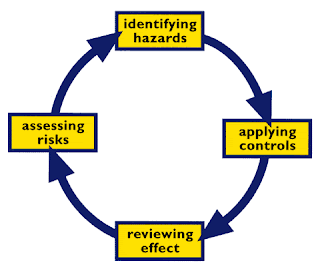When attending an accident it is very important that the area is checked for any health and safety risks, for example if there is an accident at a building site the responding services have to take it to account that there could be electricity cables and this could be a danger to both the casulties and the emergency services. Also it is vital that any evidence found, is photographed and collected, so that it can be examined and processed. This helps the emergency services, to find out how the casulty was injured.
Health and Safety Risks
Depending on the type of accident/crime scene, there are many different health and safety risks.
When the Emergency services arrive on the scene they have to identify any possible hazards that could harm casulties and themselves, they then have to deal with this hazards quickly and efficently. they would then check again to make sure that all the hazards were cleared up. An example of this is if there was a fire in a terraced house, the Fire and Rescue service would have to evacuate the area, so that if another house caught fire then no one would be at risk. They would then make sure that no one is inside the house and if there was they would have to get them out as quickly as possible. After they had done this they would have to work as a team to try and extinguish the fire.
When the Emergency services arrive on the scene they have to identify any possible hazards that could harm casulties and themselves, they then have to deal with this hazards quickly and efficently. they would then check again to make sure that all the hazards were cleared up. An example of this is if there was a fire in a terraced house, the Fire and Rescue service would have to evacuate the area, so that if another house caught fire then no one would be at risk. They would then make sure that no one is inside the house and if there was they would have to get them out as quickly as possible. After they had done this they would have to work as a team to try and extinguish the fire.
This also works for the ambulance service as well beacuse they have to identify any dangers, before thay can tend to the casualties. The ambulance service also has to be aware of any open injuries that the casulty has, as they can become infected.
Scene Preservation It is very important to preserve the accident/crime scene as there could be some evidence that helps to understand what happened or that cna help break the case. When collecting the evidence it is important to keep a photographic record of the item incase it goes missing, it is also a good idea to dust the object for fingerprints and to look for trace. Using all this as evidence can help decipher what happened during the crime/accident.
CSI:Tapton (Monday 31st January 2011)
On the 31st January we had a visit from a Forensic Anthropologist. She gave us a case that we had to try and solve. The case involved a prize dog that had been dog-knapped and the murder of a Dog Salon employee. We were then given a list of possible suspects and from there we had to decipher who had committed the offence.
She told us that the main thing to do before collecting any evidence, is to corden off the scene. This prevents any members of the public from contaminating any evidence that may be present. The next step before collecting the evidence is to photograph any trace/fingerprints/shoeprints that are found. This helps the forensics teams to keep track of any vital evidence that could help break the case. After all the evidence has been photographed and a number card/letter card(as shown in the picture below) has been placed next to the evidence, it is then collected.
The evidence is collected by using a pair of tweezers if it is a hair or a fibre, or a swab if it is blood or any other type of fluid. If the piece of evidence is big enough to be piceked up the the forensic scientist can pick it up. If the evidence is a shoeprint/tireprint then they would have to make a cast of it so that the can determind the make and model of the item in question. This is then sealed in either a box or a see-through plastic bag and the person who collected the item needs to put their inials on the evidence bag so that they can identify who collected it. Then the evidence is sent to be tested, this is to keep the chain of evidence flowing. The Forensic Anthrapologist also showed us how to tell if someone is A+/- or if they are AB+/-.
An example of number cards being used at a crime scene
Some people mix Anthropologists and Pathologists up. A Forensic Anthropologist studies bones and works out the age, gender, race and how they died from the bones. A Forensic pathologists studies the bodies of people that have been murdered or suspected of suicide. They can determine the time of death from the liver temperature and the cause of death for either obvious signs of injuries or by performing an autopsy.
Check out my blog at :http://dangerpronerobson.blogspot.com/p/responding-to-emergency-services.html and read all about the key roles and responsibilites in the public services.
Zoe,
This a good piece of work well done
Martin
An example of how the services assess the scene

